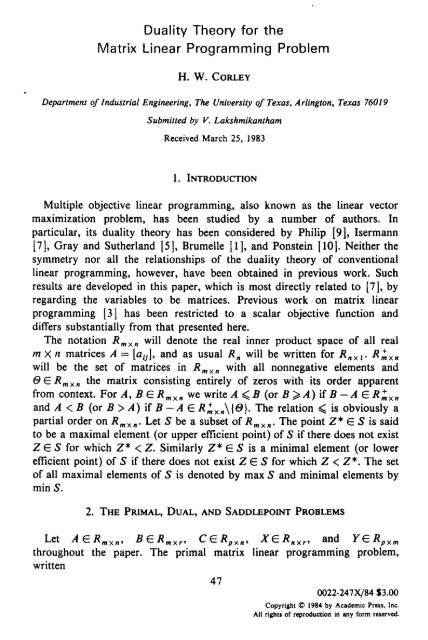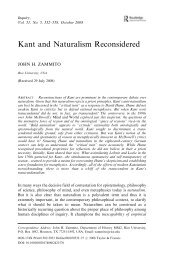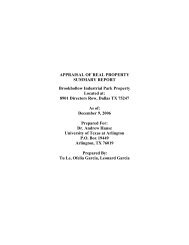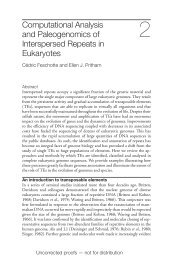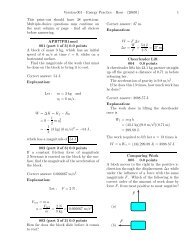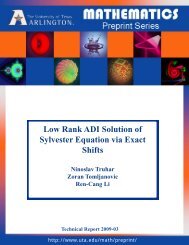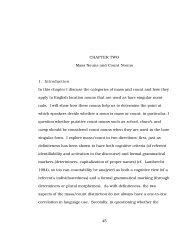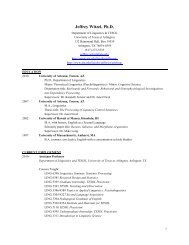Duality Theory for the Matrix Linear Programming Problem H. W. ...
Duality Theory for the Matrix Linear Programming Problem H. W. ...
Duality Theory for the Matrix Linear Programming Problem H. W. ...
You also want an ePaper? Increase the reach of your titles
YUMPU automatically turns print PDFs into web optimized ePapers that Google loves.
<strong>Duality</strong> <strong>Theory</strong> <strong>for</strong> <strong>the</strong><strong>Matrix</strong> <strong>Linear</strong> <strong>Programming</strong> <strong>Problem</strong>H. W. CORLEYDepartmentof Industrial Engineering,The University of Texas, Arlington, Texas 76019Submittedby v. LakshmikanthamReceived March 25, 19831. INTRODUCTIONMultiple objective linear programming, also known as <strong>the</strong> linear vectormaximizationproblem, has been studied by a number of authors. Inparticular, its duality <strong>the</strong>ory has been considered by Philip [9], Isermann[7], Gray and Su<strong>the</strong>rland [5], Brumelle [1], and Ponstein [10]. Nei<strong>the</strong>r <strong>the</strong>symmetry nor all <strong>the</strong> relationships of <strong>the</strong> duality <strong>the</strong>ory of conventionallinear programming, however, have been obtained in previous work. Suchresults are developed in this paper, which is most directly related to [7], byregarding <strong>the</strong> variables to be matrices. Previous work on matrixlinearprogramming [ 3] has been restricted to a scalar objective function anddiffers substantially from that presented here.The notation R m X n will denote <strong>the</strong> real inner product space of all realm X n matrices A = [au], and as usual Rn will be written <strong>for</strong> RnX1. R;xnwill be <strong>the</strong> set of matrices in R m X n with all nonnegative elements ande E R m X n <strong>the</strong> matrix consisting entirely of zeros with its order apparentfrom context. For A, B E Rmxn we write A ~B (or B :;:?;A) ifB -AE R;xnand A < B (or B > A) if B -A E R;xn\{e}. The relation ~ is obviously apartial order on Rmxn. Let S be a subset ofRmxn. The point Z* E S is saidto be a maximal element (or upper efficient point) of S if <strong>the</strong>re does not existZ E S <strong>for</strong> which Z* < Z. Similarly Z* E S is a minimal element (or lowerefficient point) of S if <strong>the</strong>re does not exist Z E S <strong>for</strong> which Z < Z*. The setof all maximal elements of S is denoted by max S and minimal elements bymin S.2. THE PRIMAL, DuAL, AND SADDLEPOINT PROBLEMSLet A E Rmxn, B E Rmxr, C E Rpxn' XE Rnxr, and YE Rpxmthroughout <strong>the</strong> paper. The primal matrix linear programming problem,written470022-247X/84 $3.00Copyright @ 1984 by Academic Press. Inc.All rights of reproduction in any <strong>for</strong>m reserved.
(P) max CXs.t.AX~E,(I)X~ e, (2),is to find all optimal X* satisfying ( I) and (2) <strong>for</strong> which CX* Emax{CX: AX~ E, X~ e}. Any X satisfying (I) and (2) is termed feasible toP, and p is said to be unbounded if some component of CX is unboundedabove <strong>for</strong> feasible X. The dual matrix linear programming problem to P,written(D) min YEs.t.YA~C, (3)Y~ e, (4)is to determine all optimal Y* satifying (3) and (4) such thatY*E E min{EY: YA ~ C, Y~ e}. Any Y satisfying (3) and (4) is similarlytermed feasible to D, and D is unbounded if some component of YE isunbounded below <strong>for</strong> feasible Y.A related problem is <strong>the</strong> saddlepoint matrix linear programming problem.With <strong>the</strong> above notation <strong>the</strong> point (X*, Y*) is said to be a saddlepoint of <strong>the</strong>Lagrangian functionL(X, Y) = CX + Y(E -AX) = YE + (C- YA)X (5)ifX* ~ e, Y* ~ e, (6)<strong>the</strong>re does not exist Y ~ e such thatcx* + Y(E -AX*) < cx* + Y*(E -AX*), (7)and <strong>the</strong>re does not exist X ~ e such thatCX* + Y*(E -AX*) < cx+ Y*(E -AX). (8)3. DUALITY RELATIONSHIPSThe duality relationships between problems p and D are now established.These results parallel <strong>the</strong> duality <strong>the</strong>ory of conventional linear programming.Results 1-4 follow easily from <strong>the</strong> previous definitions and are stated withoutproof.
Result 1. The dual of <strong>the</strong> dual is <strong>the</strong> primal.Result 2.Result 3.If X is feasible to P and Y to D, <strong>the</strong>n CX ~ YE.If X* is feasible to P, Y* is feasible to D, and CX* = Y*E,<strong>the</strong>n X*, Y* are optimal to P and D, respectively.Result 4.If P or D is unbounded, <strong>the</strong>n <strong>the</strong> o<strong>the</strong>r problem has no feasiblepoints.The remaining duality relationships are proved using <strong>the</strong> followinglemmas.LEMMA 1. If X* = [xkj] E Rnx, is optimal to P, <strong>the</strong>n <strong>the</strong>re exist scalars}..I} > 0, i = l,...,p, j = 1,..., r, such that x~, k = 1,..., n,j = 1,..., r, is optimalto <strong>the</strong> scalar linear programming problemp , n(Q) max ~ ~ ~ ).I}ClkXkj1=11=1 k=ls.t.alx1~bl}, i= 1,...,m,j= 1,...,r, (9)xkj~O' k=I,...,n,j=I,...,r, (10)where al represents row i of A and Xj columnj of x= [xkj] ERnx,.Proof It is obvious that P is equivalent to a linear vector maximizationproblem of finding an efficient point in R n' <strong>for</strong> <strong>the</strong> objective functionc1 e ecP e ee c1 e lx]e cP e ~: ERp"x,e e c1e e cPwhere Ci is row i of C, subject to (9), (10). As a result of Theorem 2 ofIsermann [6], X* = [x~] determines a properly efficient point(Xtl ,..., X:l ,..., xt"..., X:,)I <strong>for</strong> this problem. Then by Theorem 2 of GeofTrion[ 4] <strong>the</strong>re exist ).I} > 0 <strong>for</strong> which <strong>the</strong> x~ solve Q. I
LEMMA 2. Let X* be optimal to P and E = {CX: AX ~ B, X ~ 8}. Then<strong>the</strong>re exist a real number a and a linear functional I on Rpxr<strong>for</strong> whichI(Z) > 0 <strong>for</strong>allZER:xr\{8}, (11)I(Z»a <strong>for</strong>allZE[R:xr\{8}]+CX*, (12)I(Z)~a <strong>for</strong>allZEE-R:xr. (13)Proof For Z = [ZI}] E Rpxr define I(Z) = Lf=1 LJ=I ).I}ZI} <strong>for</strong> ).I} > 0 asin Lemma 1, and set a = I(CX*). Then (11) holds immediately. Moreover,from (11) <strong>for</strong> Z E R:xr\{8},I(Z + CX*) = I(Z) + I(CX*) > I(CX*) = a,yielding (12). Finally, <strong>for</strong> CXE E and WE R:xr it follows from Lemma I,(II), and <strong>the</strong> fact that 1(8)=0 that I(CX- W)=I(CX)-I(W)~I(CX)~I(CX*) = a, so (13) is established. .Theorem I next relates <strong>the</strong> primal, dual, and saddlepoint problems.THEOREM I. If X* is optimal to P, <strong>the</strong>n <strong>the</strong>re exists Y* ~ 8 such that(X*, Y*) is a saddlepoint of L(X, Y) andY*(B-AX*)=8. (14)Similarly, if Y* is optimal to D, <strong>the</strong>re exists X* ~ 8 such that (X*, Y*) is asaddlepoint of L(X, Y) and (C- Y*A)X* = 8.Proof Only <strong>the</strong> first statement will be proved since <strong>the</strong> second <strong>the</strong>nfollows readily from <strong>the</strong> symmetry of (5). From Lemmas I and 2 <strong>the</strong>re existsa linear functional Ion R p x r such that ( 11) is satisfied and X* maximizes<strong>the</strong> scalar objective function I(CX) subject to (I), (2). By a standardLagrange multiplier <strong>the</strong>orem in [8] <strong>the</strong>re exists a linear functional u* onRmxr such that u*(W) ~ 0 <strong>for</strong> all WE R:.xr'andu*(B-AX*)=O, (15)I(CX*)+u*(B-AX*)~I(CX)+u*(B-AX) <strong>for</strong>aIIX~8. (16)Choose Z* E R:xr\ {8} <strong>for</strong> which I(Z*) = I and define Y* E Rpxm suchthat Y*W = u*(W) Z*. Then (14) follows from (15), and Y*WE R:xr <strong>for</strong>all WE R~xr. Hence Y* ~ e and (6) is proved since X* ~ e. The definitionof Y* and (16) next yield thatI[CX- CX* + Y*(B -AX) -Y*(B -AX*)] ~ 0 <strong>for</strong> all X~ e. (17)
It now followsfrom (11) and (17) thatX- CX* + Y*(B -AX) -Y*(B -AX*) e R:xr\ {8} <strong>for</strong> all X;;:!: 8to prove (8). Finally, suppose that <strong>the</strong>re exists YE Rpxm' Y;;:!: 8, satisfyingCX* + Y*(B -AX*) -CX* -Y(B -AX*) E R:xr\{8}. (18)Then (14) and (18) give that Y(B-AX*)ER:xr\{8}, contradicting <strong>the</strong>assumption that Y;;:!: 8 and establishing (7) to complete <strong>the</strong> proof. ITHEOREM 2. If (X*, Y*) is a saddle point of L(X, Y), <strong>the</strong>n X* is optimalto P, Y* is optimal to D, Y*(B -AX*) = 8, and (Y*A -C)X* = 8.Proof The result follows directly from Theorem I of Corley [2] and itsproof, with obvious changes in terminology, and from <strong>the</strong> symmetry of(5). ITheorem 3 next uses Theorems I and 2 to establish an analog to <strong>the</strong>strong duality <strong>the</strong>orem of standard linear programming.THEOREM 3. If <strong>the</strong>re exists an optimal X* to P, <strong>the</strong>n <strong>the</strong>re exists anoptimal Y* to D <strong>for</strong> which CX* = Y* B and Y*(B -AX*) = e. Similarly, if<strong>the</strong>re exists an optimal Y* to D, <strong>the</strong>re exists an optimal X* to P <strong>for</strong> whichCX* = Y*B and (Y*A -C)X* = e.Proof Only <strong>the</strong> first statement need be proved. If X* is optimal to P, byTheorem 1 <strong>the</strong>re exists Y* such that (X*, Y*) is a saddlepoint of L(X, Y)and Y* (B -AX* ) = e. Then by Theorem 2 Y* is optimal to D and(Y* A -C) X* = e. It follows that CX* = Y* AX = Y* B to establish <strong>the</strong><strong>the</strong>orem.IAs opposed to scalar linear programming Theorem 3 does not say thatCX* = Y*B <strong>for</strong> any X* optimal to P and any Y* optimal to D. However,<strong>the</strong> following corollary to Theorem I does hold.COROLLARY. max{CX:AX~B, X;;:!: e} = min{YB: YA ;;:!: C, Y;;:!: e}.REFERENCESI. s. BRUMELLE, <strong>Duality</strong> <strong>for</strong> multiple objective convex programs, Math. Oper. Res. 6(1981),159-172.2. H. W. CORLEY, <strong>Duality</strong> <strong>the</strong>ory <strong>for</strong> maximizations with respect to cones, I. Math. Anal.Appl. 84 (1981),560-568.3. B. D. CRAVEN AND B. MOND, <strong>Linear</strong> programming with matrix variables, <strong>Linear</strong> AlgebraAppl. 38 (1981), 73-80.
4. A. M GEOFFRION, Proper efficiency and <strong>the</strong> <strong>the</strong>ory of vector maximization, J. Malh.Anal. Appl. 22 (1968),618-630.5. D. F. GRAY AND W. R. S. SUTHERLAND, Inverse <strong>Programming</strong> and <strong>the</strong> linear vectormaximization problem, J. Oplim. <strong>Theory</strong> Appl. 30 (1980), 523-534.6. H. ISERMANN, Proper efficiency and <strong>the</strong> linear vector maximum problem, Oper. Res. 22(1974), 189-191.7. H. ISERMANN, On some relations between a dual pair of multiple objective linearprograms, Z. Oper. Res 22 (1979), 34-41.8. D. G. LUENaERGER, "Optimization by Vector Space Methods," Wiley, New York, 1969.9. J. PHILIP, Algorithms <strong>for</strong> <strong>the</strong> vector maximization problem, Malh. <strong>Programming</strong> 2(1972), 207-229.10. J. PONSTEIN, "On <strong>the</strong> Dualization of Multiobjective Optimization <strong>Problem</strong>s," Report OR.8201, 1982, Econometric Institute, University of Groningen, Groningen, The Ne<strong>the</strong>rlands


